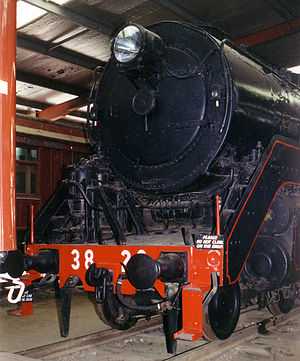3820
| NSWGR 3820 | |
|---|---|
|
3820 in its black livery, which was used on these locos as a cost-cutting measure. | |
| Type and origin | |
| Power type | Steam |
| Builder | NSWGR Eveleigh Workshops |
| Build date | 1947 |
| Specifications | |
| Configuration | 4-6-2 |
| UIC classification | 2′C1′ h2 |
| Gauge | 4 ft 8 1⁄2 in (1,435 mm) |
| Driver diameter | 5 ft 9 in (1,753 mm) |
| Wheelbase | 65 ft 7 1⁄8 in (19.99 m) |
| Locomotive and tender combined weight | 201 tons (204,000 kg) when in steam |
| Fuel type | Coal |
| Fuel capacity | 14 tons (14,224 kg) |
| Water capacity | 8,100 imp gal (37,000 l; 9,700 US gal) |
| Boiler pressure | 245 lbf/in2 (1.69 MPa) |
| Firegrate area | 47 sq ft (4.4 m2) |
| Heating surface: – Tubes | 142 tubes, 2¼ in (51.7 mm) dia each |
| – Flues | 36 flues, 2¼ in (139 mm) dia each |
| – Total | 3,367.79 sq ft (312.878 m2) |
| Superheater type | 36 element |
| Cylinders | Two |
| Cylinder size | 21.5 in × 26 in (546 mm × 660 mm) |
| Valve gear | Walschaerts |
| Performance figures | |
| Tractive effort | 36,200 lbf (161.03 kN) |
| Career | |
| Operator(s) | NSWGR |
| Class | 38 class |
| Number in class | 20 of 30 |
| Number(s) | 3820 |
| Locale | New South Wales, Australia |
| First run | 1947 |
| Last run | Withdrawn 1970 |
| Disposition | Static exhibit |

3820 (Pronounced thirty-eight twenty) is a two-cylinder simple, non-condensing, superheated, ‘Pacific’ 4-6-2 C38 class steam locomotive built in 1947.
Construction
3820 was built in 1947 by the New South Wales Government Railways at the Eveleigh Workshops. It was the 20th of 30 C38 class locomotives built to haul express trains and replace the lower powered C36 class on main line working. The first 5 road numbers 3801–3805 were built at Granville to a streamlined design, whilst the later 25 locos in the class, which included 3820, were built by the NSWGR and were unstreamlined.
The 38 class were first conceived in 1938. They suffered many delays during construction – mostly due to the Second World War.
Demise and Preservation
3820 had the distinction of many "lasts":[1]
- with 3813 it was the last C38 class to be overhauled whilst in regular service, both being overhauled together at Cardiff Workshops (3813 outshopped on 12 December 1968, 3820 outshopped on 13 December 1968);
- hauled official last steam hauled ‘Riverina Express’ in May 1964;
- last official revenue steam duty on the main south line beyond Goulburn May 1964;
- last C38 in revenue service when withdrawn on 29 December 1970;
- worked the official last steam hauled express passenger train in Australia, the ‘Newcastle Flyer’ on 29 December 1970
- together with locomotives 3203 and 3526, participated in the final steam rail-tour.
Before 3820's move to the new site at Thirlmere, the loco did some restricted steam excursion for the RTM, including a journey to Melbourne with 3801, and the famous 'Last Run' which it triple headed with 3203 & 3526. 3820 wasn't used for any of the three Enfield Steam Extravaganzas. 3820 was steamed on 1 January 1975, to act as a standby for 3801, which was used to haul fundraising trains for Cyclone Tracey survivors.[1]
3820 is kept as a static exhibit at the New South Wales Rail Transport Museum's locomotive museum at Thirlmere, New South Wales, where it has resided since travelling there from Enfield under its own power from in 1975 for the last time. 3820's livery is black with red lining, whereas restored C38 locomotives 3801 and 3830 wear a green livery. 3820 is considered to be of historic significance as the only remaining C38 locomotive that remains in the same condition it was in at time of withdrawal (3801, 3813 and 3830 each having been stripped down for restoration) and as such retains a significant amount of evidence for research purposes.[1]
See also
References
- ↑ 1.0 1.1 1.2 "NSWRTM - 3820". New South Wales Rail Transport Museum. Retrieved 4 February 2010.
| ||||||||||||||||||||||||||||||||||||||
